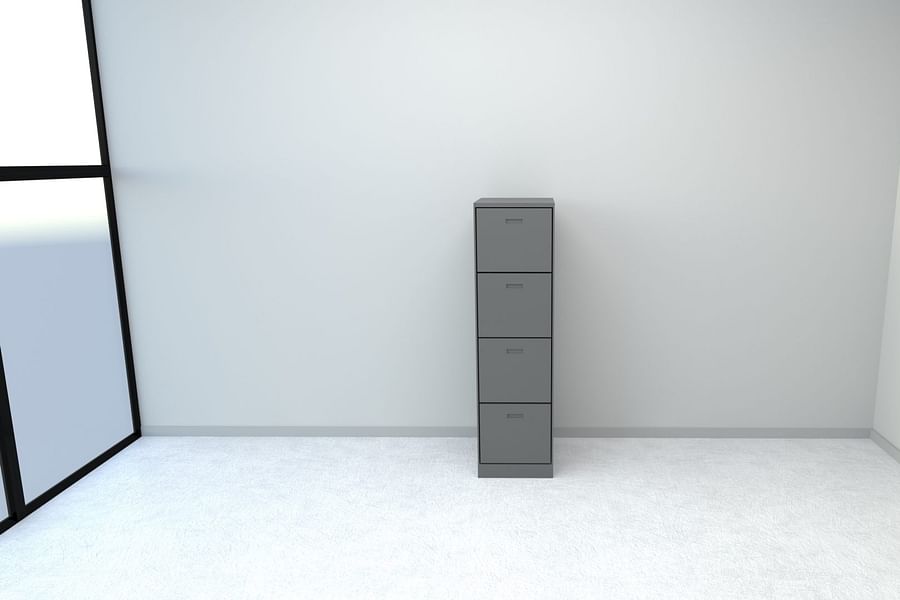3 Doors Cabinet - Industrial Factory Original Color 1930

The allure of industrial design has been captivating homeowners and interior designers alike for decades, conjuring images of spacious lofts and the chic reuse of commercial spaces. The 3 Doors Cabinet from the Industrial Factory Original Color 1930 collection embodies this raw aesthetic perfectly, offering both form and function to those looking to infuse their living spaces with a touch of historical authenticity. This piece, with its robust construction and timeless appeal, not only serves as a practical storage solution but also stands as a statement piece that anchors any room with its presence.
The industrial design movement began in the early 20th century when factories and warehouses started closing down, leaving behind a wealth of materials and furnishings that were robustly built to withstand heavy use. These pieces were characterized by their utilitarian simplicity, sturdy materials like steel and wood, and their no-frills approach to design. Today, these elements are celebrated for their durability and character, making them highly sought after for modern interiors. The 3 Doors Cabinet is a prime example of this trend, having preserved its original color and finish from the 1930s.
A genuine artifact from the 1930s, this cabinet showcases features that resonate with fans of industrial design. The body is constructed from heavy-duty metal that has stood the test of time. The original color, often a deep green or gray shade indicative of factory equipment from that era, remains intact on this piece – a rarity among surviving furniture. Its three doors open to reveal ample storage space while retaining an unrefined charm that makes it an instant focal point in any room.







Integrating such a distinctive item into your home decor requires some finesse; it should complement your existing furnishings while standing out as a unique element. For those looking to create a cohesive look within their home office or kitchen space, exploring 3D wall panel designs or stylish kitchen decor ideas can provide inspiration on how to blend modern touches with vintage pieces like the cabinet.
Melding vintage industrial furniture into contemporary decor isn't just about placing an old piece in a room; it's about creating harmony between different eras and styles. It involves considering color schemes, balancing textures, and ensuring functionality remains paramount. For instance, pairing the cabinet with softer textiles can offset its hard lines and cold metal surfaces. Additionally, when situated in a home office designed with practical 3D wall decor ideas, it can add an unexpected layer of depth to your workspace.
The cabinet's utilitarian design also aligns well with principles found in mid-century modern furniture – another popular style known for its emphasis on function over form. For those interested in blending these two styles together seamlessly within their Southern home's aesthetic can find valuable insights at Grits & Grace.
To truly appreciate the craftsmanship behind these historical pieces is to understand their origins within the industrial sector – an area where aesthetics met practicality head-on. Those curious about how industrial elements have influenced other areas of design may find Foresight Creative's exploration on trucking logo designs particularly enlightening.
Preserving the authenticity of your 1930s industrial factory cabinet is key to maintaining its value and charm. The original color, often a testament to the era's manufacturing style, should be treated with care. When undertaking restoration, it’s important to use period-appropriate techniques and materials. This not only ensures a faithful restoration but also helps in preserving the piece's history.
Regular maintenance is also crucial for these antique pieces. Dusting with a soft cloth and avoiding harsh chemicals will keep the cabinet in top condition. For deeper cleans, opt for gentle soaps that won't strip away the years of character embedded in the paint. If you're unsure about how to properly care for your cabinet, consulting with a professional restorer can be invaluable.
The rugged charm of an industrial factory cabinet can blend seamlessly into contemporary interiors with a bit of creativity. Consider using your cabinet as an accent piece in a minimalist setting, where its history can stand out against clean lines and modern materials. Alternatively, integrate it into an eclectic mix of mid-century modern furnishings for a layered, time-spanning aesthetic.
The juxtaposition of old and new can create a dynamic space that reflects both your personal style and respect for historical design. For example, placing your 1930s cabinet against a backdrop of stylish 3D wall panels adds dimensionality while highlighting the piece's industrial roots.
The provenance—or history of ownership—of vintage furniture can significantly enhance its value and appeal. With items like your 1930s cabinet, any documentation or known history adds depth to its story. Collectors and enthusiasts often seek out pieces with a clear lineage or those tied to significant historical events or locations.
If your cabinet has such a backstory, it's worth documenting and preserving this information carefully. Sharing the tale behind your unique piece can make it even more special to you and potentially increase its desirability should you ever decide to sell.
Incorporating vintage industrial furniture like the 3 Doors Cabinet from the 1930s requires both an appreciation for its history and an eye for design. Whether you're using it as functional storage or as a statement piece, its presence in your home serves as a bridge between past craftsmanship and present-day style sensibilities.
To further explore how you might incorporate this type of furniture into your home office or dining room setting, consider taking these style quizzes to find your perfect match:
Maintaining the integrity of your vintage cabinet while making it work within modern interiors is not only possible but can add unparalleled character to any space. With careful restoration, thoughtful placement, and an understanding of its historical significance, you'll ensure that this piece remains treasured for many years to come.
Post a comment